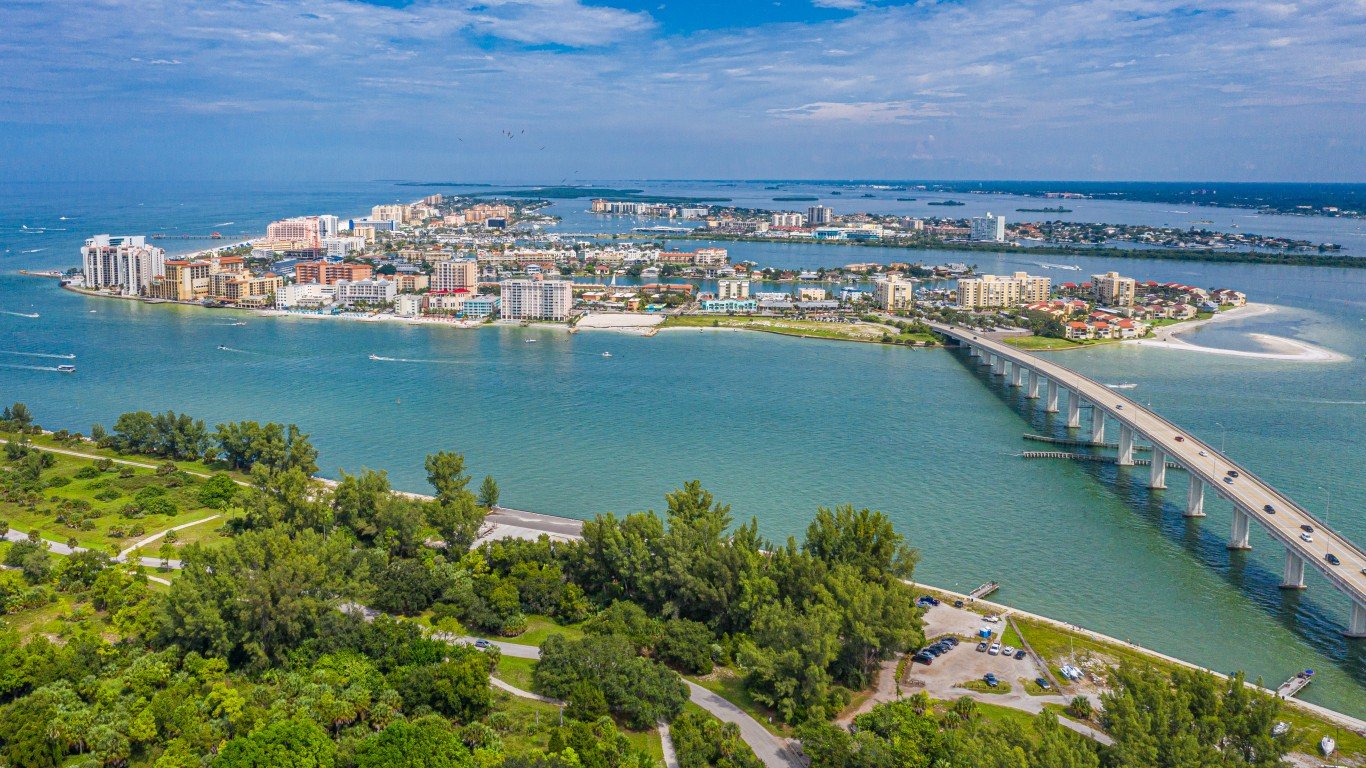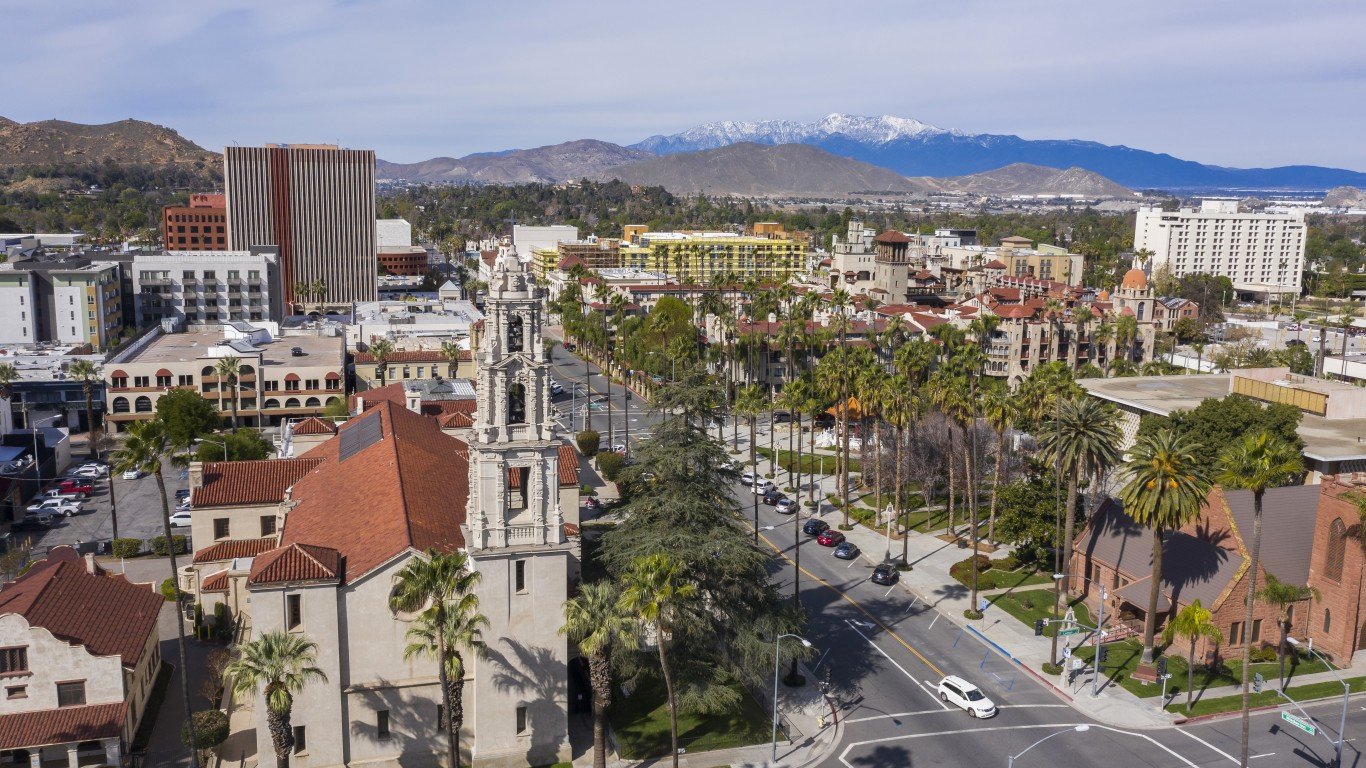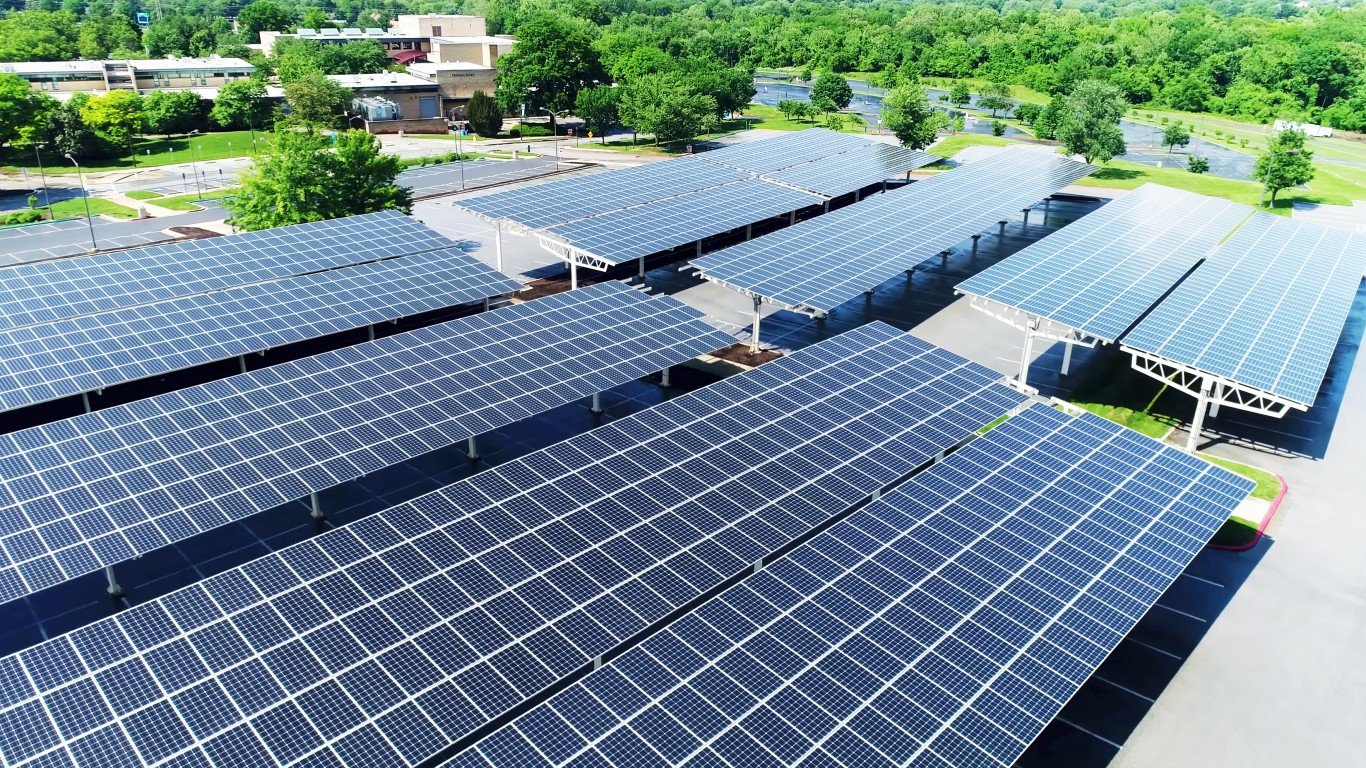

The top two largest metropolitan economies in the United States would be easy guesses for most Americans. New York and Los Angeles are well known to be among the world’s premiere and economically potent powerhouses, homes to Wall Street and Hollywood.
But which U.S. metro areas have the next largest economies? To identify the 25 biggest American city economies in 2020, 24/7 Wall St. reviewed real gross domestic product for 2020 from the Bureau of Economic Analysis for 383 U.S. metro areas with data. GDP is the total value of goods and services produced in an area.
Data on GDP growth from 2001-2020, the largest industry in 2020, and the industry with the largest GDP growth over that time also came from the BEA. Population figures and median household income are five-year estimates for 2019 from the Census Bureau 2019 American Community Survey.
Drilling down the list of the largest metro-area economies, the order becomes less intuitive. For example, though Silicon Valley (centered around San Jose, California) has an enormous tech-based economy, it ranks 12th largest by GDP, smaller than the metro-area economies of Atlanta, Houston, and Dallas, all of which have much larger populations. (Here are the 50 largest cities in America.)
The top 25 largest U.S. metropolitan-area economies are home to 135.1 million people, or 42% of the U.S. population. They contribute $9.3 trillion, or nearly 51%, to the country’s real gross domestic product. Five of these economically crucial areas are located in California, and three are based in Texas. (These are America’s largest and smallest state economies.)
Nine of the top 25 largest economies in the United States are metropolitan areas that sit in two or more states, such as the St. Louis metro area, which includes parts of Missouri and Illinois, or the Minneapolis metropolitan area, which includes parts of Minnesota and Wisconsin. The Philadelphia metropolitan area touches four states: Pennsylvania, New Jersey, Delaware, and Maryland. The New York City economic zone includes portions of New Jersey and Pennsylvania.
Click here to see America’s biggest city economies
Click here to read our detailed methodology

25. Tampa-St. Petersburg-Clearwater, FL
> Real GDP, 2020: $145.50 billion
> GDP growth, 2001-2020: $45.20 billion, or 45.1% – #101 largest
> Largest industry GDP, 2020: Private services-providing industries ($114.34 billion)
> Industry with largest growth, 2001-2020: Information (+133.95%)
> Median household income, 2019: $55,285 – #180 lowest
> Population, 2019: 3,097,859 – #18 largest
[in-text-ad]

24. Portland-Vancouver-Hillsboro, OR-WA
> Real GDP, 2020: $148.46 billion
> GDP growth, 2001-2020: $61.39 billion, or 70.5% – #35 largest
> Largest industry GDP, 2020: Finance, insurance, real estate, rental, and leasing ($27.04 billion)
> Industry with largest growth, 2001-2020: Manufacturing (+205.87%)
> Median household income, 2019: $74,792 – #33 highest
> Population, 2019: 2,445,761 – #25 largest
23. Austin-Round Rock-Georgetown, TX
> Real GDP, 2020: $148.88 billion
> GDP growth, 2001-2020: $87.42 billion, or 142.2% – #6 largest
> Largest industry GDP, 2020: Private services-providing industries ($108.28 billion)
> Industry with largest growth, 2001-2020: Mining, quarrying, and oil and gas extraction (+459.98%)
> Median household income, 2019: $76,844 – #28 highest
> Population, 2019: 2,114,441 – #31 largest

22. St. Louis, MO-IL
> Real GDP, 2020: $149.86 billion
> GDP growth, 2001-2020: $17.44 billion, or 13.2% – #105 smallest
> Largest industry GDP, 2020: Finance, insurance, real estate, rental, and leasing ($29.16 billion)
> Industry with largest growth, 2001-2020: Finance and insurance (+35.07%)
> Median household income, 2019: $63,705 – #95 highest
> Population, 2019: 2,805,190 – #20 largest
[in-text-ad-2]

21. Charlotte-Concord-Gastonia, NC-SC
> Real GDP, 2020: $153.40 billion
> GDP growth, 2001-2020: $61.91 billion, or 67.7% – #39 largest
> Largest industry GDP, 2020: Finance, insurance, real estate, rental, and leasing ($38.59 billion)
> Industry with largest growth, 2001-2020: Professional and business services (+138.06%)
> Median household income, 2019: $63,217 – #100 highest
> Population, 2019: 2,545,560 – #22 largest

20. Riverside-San Bernardino-Ontario, CA
> Real GDP, 2020: $160.48 billion
> GDP growth, 2001-2020: $58.79 billion, or 57.8% – #57 largest
> Largest industry GDP, 2020: Private services-providing industries ($109.91 billion)
> Industry with largest growth, 2001-2020: Utilities (+201.43%)
> Median household income, 2019: $65,121 – #82 highest
> Population, 2019: 4,560,470 – #13 largest
[in-text-ad]

19. Baltimore-Columbia-Towson, MD
> Real GDP, 2020: $176.75 billion
> GDP growth, 2001-2020: $45.07 billion, or 34.2% – #158 largest
> Largest industry GDP, 2020: Finance, insurance, real estate, rental, and leasing ($34.67 billion)
> Industry with largest growth, 2001-2020: Management of companies and enterprises (+438.46%)
> Median household income, 2019: $81,598 – #14 highest
> Population, 2019: 2,796,733 – #21 largest

18. Denver-Aurora-Lakewood, CO
> Real GDP, 2020: $196.70 billion
> GDP growth, 2001-2020: $62.16 billion, or 46.2% – #92 largest
> Largest industry GDP, 2020: Private services-providing industries ($150.43 billion)
> Industry with largest growth, 2001-2020: Mining, quarrying, and oil and gas extraction (+189.76%)
> Median household income, 2019: $79,664 – #22 highest
> Population, 2019: 2,892,066 – #19 largest

17. San Diego-Chula Vista-Carlsbad, CA
> Real GDP, 2020: $207.75 billion
> GDP growth, 2001-2020: $65.68 billion, or 46.2% – #91 largest
> Largest industry GDP, 2020: Private services-providing industries ($137.01 billion)
> Industry with largest growth, 2001-2020: Durable goods manufacturing (+220.59%)
> Median household income, 2019: $78,980 – #24 highest
> Population, 2019: 3,316,073 – #17 largest
[in-text-ad-2]

16. Detroit-Warren-Dearborn, MI
> Real GDP, 2020: $220.77 billion
> GDP growth, 2001-2020: $ 0.66 billion, or 0.3% – #44 smallest
> Largest industry GDP, 2020: Private services-providing industries ($160.02 billion)
> Industry with largest growth, 2001-2020: Health care and social assistance (+23.08%)
> Median household income, 2019: $60,984 – #127 highest
> Population, 2019: 4,317,848 – #14 largest

15. Minneapolis-St. Paul-Bloomington, MN-WI
> Real GDP, 2020: $235.35 billion
> GDP growth, 2001-2020: $59.03 billion, or 33.5% – #167 largest
> Largest industry GDP, 2020: Finance, insurance, real estate, rental, and leasing ($49.64 billion)
> Industry with largest growth, 2001-2020: Information (+117.31%)
> Median household income, 2019: $80,421 – #21 highest
> Population, 2019: 3,573,609 – #16 largest
[in-text-ad]

14. Phoenix-Mesa-Chandler, AZ
> Real GDP, 2020: $240.71 billion
> GDP growth, 2001-2020: $90.38 billion, or 60.1% – #48 largest
> Largest industry GDP, 2020: Private services-providing industries ($180.72 billion)
> Industry with largest growth, 2001-2020: Information (+246.13%)
> Median household income, 2019: $63,883 – #93 highest
> Population, 2019: 4,761,603 – #11 largest

13. Miami-Fort Lauderdale-Pompano Beach, FL
> Real GDP, 2020: $311.36 billion
> GDP growth, 2001-2020: $84.07 billion, or 37.0% – #144 largest
> Largest industry GDP, 2020: Private services-providing industries ($258.94 billion)
> Industry with largest growth, 2001-2020: Management of companies and enterprises (+119.89%)
> Median household income, 2019: $56,775 – #191 highest
> Population, 2019: 6,090,660 – #7 largest

12. San Jose-Sunnyvale-Santa Clara, CA
> Real GDP, 2020: $342.17 billion
> GDP growth, 2001-2020: $226.40 billion, or 195.6% – #3 largest
> Largest industry GDP, 2020: Private services-providing industries ($241.60 billion)
> Industry with largest growth, 2001-2020: Information (+1,380.03%)
> Median household income, 2019: $122,478 – #1 highest
> Population, 2019: 1,987,846 – #35 largest
[in-text-ad-2]

11. Atlanta-Sandy Springs-Alpharetta, GA
> Real GDP, 2020: $369.86 billion
> GDP growth, 2001-2020: $115.72 billion, or 45.5% – #95 largest
> Largest industry GDP, 2020: Private services-providing industries ($300.34 billion)
> Industry with largest growth, 2001-2020: Utilities (+93.74%)
> Median household income, 2019: $68,316 – #61 highest
> Population, 2019: 5,862,424 – #9 largest

10. Seattle-Tacoma-Bellevue, WA
> Real GDP, 2020: $378.15 billion
> GDP growth, 2001-2020: $180.39 billion, or 91.2% – #14 largest
> Largest industry GDP, 2020: Private services-providing industries ($296.96 billion)
> Industry with largest growth, 2001-2020: Information (+408.74%)
> Median household income, 2019: $86,856 – #9 highest
> Population, 2019: 3,871,323 – #15 largest
[in-text-ad]

9. Philadelphia-Camden-Wilmington, PA-NJ-DE-MD
> Real GDP, 2020: $382.41 billion
> GDP growth, 2001-2020: $75.10 billion, or 24.4% – #162 smallest
> Largest industry GDP, 2020: Finance, insurance, real estate, rental, and leasing ($83.50 billion)
> Industry with largest growth, 2001-2020: Information (+370.78%)
> Median household income, 2019: $72,343 – #46 highest
> Population, 2019: 6,079,130 – #8 largest

8. Boston-Cambridge-Newton, MA-NH
> Real GDP, 2020: $412.68 billion
> GDP growth, 2001-2020: $128.57 billion, or 45.3% – #99 largest
> Largest industry GDP, 2020: Professional and business services ($95.87 billion)
> Industry with largest growth, 2001-2020: Information (+197.51%)
> Median household income, 2019: $90,333 – #5 highest
> Population, 2019: 4,832,346 – #10 largest

7. Houston-The Woodlands-Sugar Land, TX
> Real GDP, 2020: $455.30 billion
> GDP growth, 2001-2020: $161.26 billion, or 54.8% – #64 largest
> Largest industry GDP, 2020: Private services-providing industries ($284.36 billion)
> Industry with largest growth, 2001-2020: Management of companies and enterprises (+566.79%)
> Median household income, 2019: $67,516 – #67 highest
> Population, 2019: 6,884,138 – #5 largest
[in-text-ad-2]

6. Dallas-Fort Worth-Arlington, TX
> Real GDP, 2020: $477.02 billion
> GDP growth, 2001-2020: $203.49 billion, or 74.4% – #27 largest
> Largest industry GDP, 2020: Finance, insurance, real estate, rental, and leasing ($95.40 billion)
> Industry with largest growth, 2001-2020: Information (+193.87%)
> Median household income, 2019: $70,281 – #54 highest
> Population, 2019: 7,320,663 – #4 largest

5. Washington-Arlington-Alexandria, DC-VA-MD-WV
> Real GDP, 2020: $485.14 billion
> GDP growth, 2001-2020: $152.88 billion, or 46.0% – #94 largest
> Largest industry GDP, 2020: Private services-providing industries ($344.03 billion)
> Industry with largest growth, 2001-2020: Manufacturing and information (+102.35%)
> Median household income, 2019: $103,751 – #3 highest
> Population, 2019: 6,196,585 – #6 largest
[in-text-ad]

4. San Francisco-Oakland-Berkeley, CA
> Real GDP, 2020: $525.83 billion
> GDP growth, 2001-2020: $217.75 billion, or 70.7% – #34 largest
> Largest industry GDP, 2020: Private services-providing industries ($393.43 billion)
> Industry with largest growth, 2001-2020: Information (+493.35%)
> Median household income, 2019: $106,025 – #2 highest
> Population, 2019: 4,701,332 – #12 largest

3. Chicago-Naperville-Elgin, IL-IN-WI
> Real GDP, 2020: $593.97 billion
> GDP growth, 2001-2020: $80.41 billion, or 15.7% – #119 smallest
> Largest industry GDP, 2020: Finance, insurance, real estate, rental, and leasing ($132.47 billion)
> Industry with largest growth, 2001-2020: Administrative and support and waste management and remediation services (+56.48%)
> Median household income, 2019: $71,770 – #49 highest
> Population, 2019: 9,508,605 – #3 largest

2. Los Angeles-Long Beach-Anaheim, CA
> Real GDP, 2020: $880.23 billion
> GDP growth, 2001-2020: $247.82 billion, or 39.2% – #129 largest
> Largest industry GDP, 2020: Private services-providing industries ($668.44 billion)
> Industry with largest growth, 2001-2020: Information (+168.66%)
> Median household income, 2019: $72,998 – #42 highest
> Population, 2019: 13,249,614 – #2 largest
[in-text-ad-2]

1. New York-Newark-Jersey City, NY-NJ-PA
> Real GDP, 2020: $1.50 trillion
> GDP growth, 2001-2020: $303.87 billion, or 25.4% – #173 smallest
> Largest industry GDP, 2020: Finance, insurance, real estate, rental, and leasing ($449.09 billion)
> Industry with largest growth, 2001-2020: Information (+185.74%)
> Median household income, 2019: $78,773 – #25 highest
> Population, 2019: 19,294,236 – #1 largest
Methodology
To identify the 25 biggest American city economies in 2020, 24/7 Wall St. reviewed real gross domestic product for 2020 from the Bureau of Economic Analysis. Meros areas were ranked by real GDP (383 had data). Information about GDP growth from 2001-2020, the largest industry in 2020, and the industry with the largest GDP growth over that time also came from the BEA. Population figures, unemployment rate, and median household income are five-year estimates for 2019 from the Census Bureau 2019 American Community Survey.
Essential Tips for Investing: Sponsored
A financial advisor can help you understand the advantages and disadvantages of investment properties. Finding a qualified financial advisor doesn’t have to be hard. SmartAsset’s free tool matches you with up to three financial advisors who serve your area, and you can interview your advisor matches at no cost to decide which one is right for you. If you’re ready to find an advisor who can help you achieve your financial goals, get started now.
Investing in real estate can diversify your portfolio. But expanding your horizons may add additional costs. If you’re an investor looking to minimize expenses, consider checking out online brokerages. They often offer low investment fees, helping you maximize your profit.
Thank you for reading! Have some feedback for us?
Contact the 24/7 Wall St. editorial team.
 24/7 Wall St.
24/7 Wall St.



